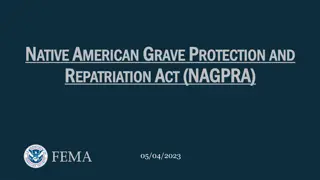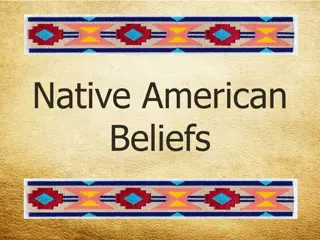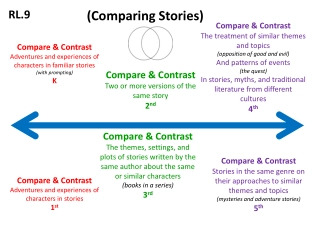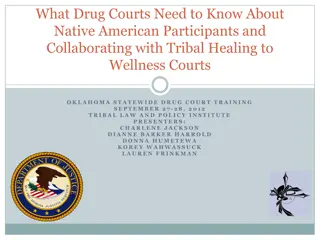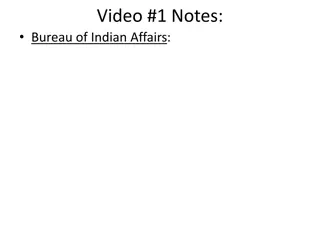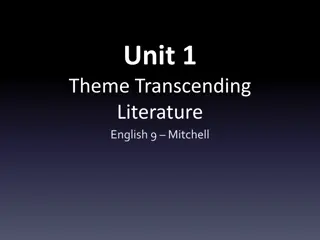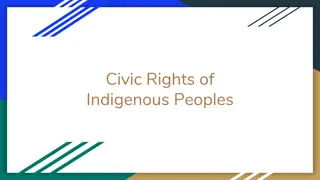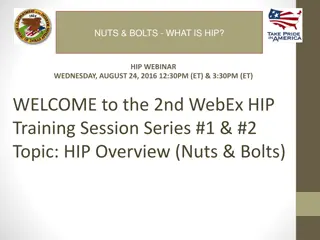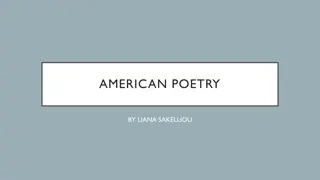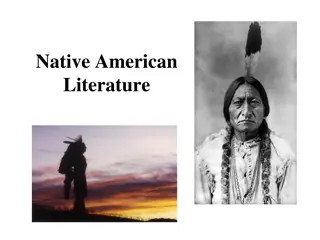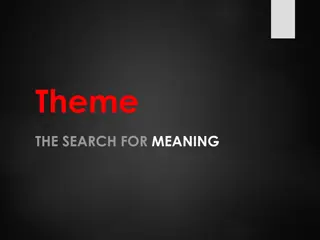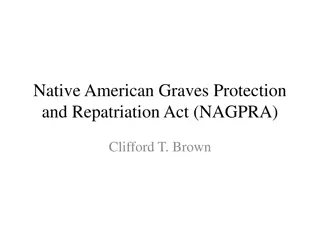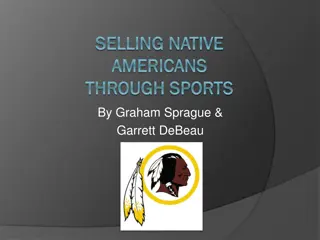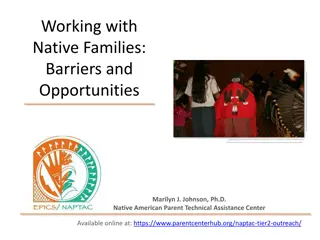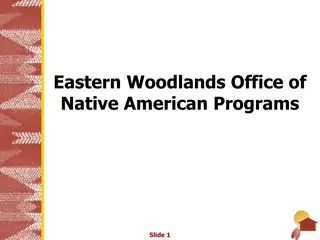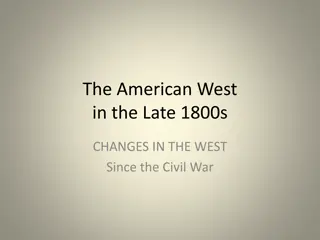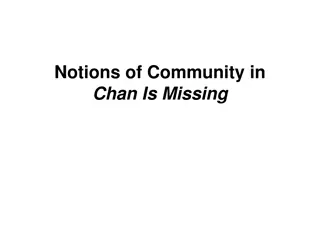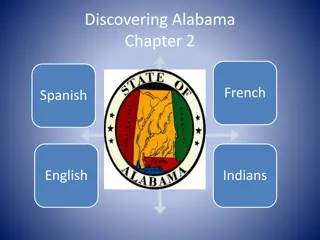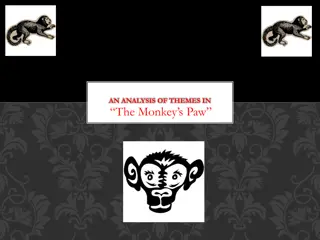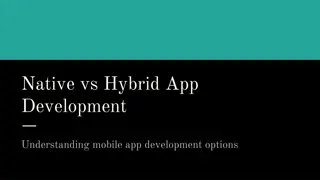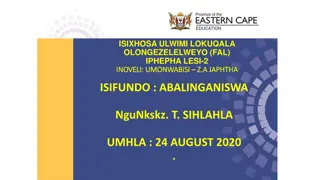Exploring Native American Literature: Creation Stories and Themes
Delve into the rich world of Native American literature, focusing on creation myths, oral traditions, and cultural themes. Discover how these stories explain the origins of the world, human nature, and societal values, as passed down through generations. Explore key texts like "The World on the Turtle's Back" and Trickster Tales, reflecting the deep connection between storytelling and identity in Native American cultures.
Download Presentation

Please find below an Image/Link to download the presentation.
The content on the website is provided AS IS for your information and personal use only. It may not be sold, licensed, or shared on other websites without obtaining consent from the author. Download presentation by click this link. If you encounter any issues during the download, it is possible that the publisher has removed the file from their server.
E N D
Presentation Transcript
Early American Literature NATIVE AMERICAN LITERATURE AND COLONIAL LITERATURE
How do we make sense of our world? Since the beginning of time, people of all cultures have gathered to discuss one of life s biggest question: how was the world created?
Native American Experience 1200 BC - 1600 Characteristics of Native American Literature Oral Tradition Held a Moral Message Used Animals and Nature Interchangeably Believed in the Power of the Metaphor Explained the un-explainable Creation of the world Where humans came from Why certain things are as they are Native American Prezi
Native American Lit. Vocabulary myth a traditional story, usually involving supernatural beings or events, that explains how some aspect of human nature or the natural world came to be. creation myth a specific kind of myth that typically describes how the universe, earth, and life began explains the working of the natural world supports and validates social customs and values
How do we make sense of our world? The Iroquois creation myth you re about to read offers one answer to this question about the origin of the world. The World on the Turtle s Back is filled with conflict and compelling characters. The Iroquois passed down this story from one generation to the next by telling it in elaborate performances. In the 1800 s an Iroquois author recorded one version of the story. Today, more than 25 written versions of the story exist.
The World on the Turtles Back Website
The World on the Turtles Back According to Native American literature scholars Larry Evers and Paul Pavich, creation stories remind the people of who and what they are, why they are in this particular place, and how they should continue to live here. Do you think that The World on the Turtle s Back fulfills these functions for the Iroquois people? Explain citing textual evidence from the text to support your response.
The Coyote and the Buffalo Trickster Tales: a type of folk tale that features either an animal or a human character who engages in deceit, violence, and magic. They often explain some aspect of human nature or how the natural world came to be.
The Coyote and the Buffalo Trickster tales endure because they are meant to be a fun read and also to teach a lesson or moral. What does Coyote and the Buffalo teach or explain? Support your answer with textual evidence. 2. A trickster can be defined as one who dupes others and is always duped himself and who possesses no values and is at the mercy of his own passions and desires. How does Coyote fit this definition of a trickster? Support your answer with textual evidence. 1.
Socratic Seminar The World on the Turtle s Back The Coyote and the Buffalo College Prep. Socratic Seminar Questions Honors Socratic Seminar Questions Coyote and the Buffalo Handout
Historical Narratives (Slave and Puritan Literature) Accounts of real-life historical experiences, written by either a person who experienced those events or someone who studied or observed them. Historical narratives can be divided into two categories Primary sources materials written by people who were either participants or observers of the events written about. (letters, diaries, journals, speeches, autobiographies, interviews) Secondary sources records of events written by people who were not directly involved in the events. (biographies)
Primary or Secondary Source?? The handwritten will of a European settler in Virginia dated 1610 An encyclopedia article entitled Puritans The Mayflower Compact, an agreement written and signed by passengers on the Mayflower in 1620 Primary Secondary Primary A record of births and deaths kept by the residents of a village in colonial Virginia A book entitled, Massachusetts Before the Pilgrims, written in 1975. Primary Secondary
What Makes an Explorer? What is it that causes people to seek out the unknown? What s the story behind the glory? What enables some to survive while others fail? What character traits do modern-day explorers and early explorers share?
La Relacion Much of our understanding of pre-colonial America comes from the first-person accounts of its early explorers. (historical narratives) The primary source documents of those first Europeans to view the American landscape describe in vivid detail its many sights and wonders, as well as its dangers and challenges. The author of La Relacion , Alvar Nunez Cabeze de Vaca, chronicles his eight years of wandering through Florida, Texas, and Mexico.
Writing Assignment Explorers often keep journals of their experiences. These accounts from the writings of Lewis and Clark to the reports of a modern astronaut describe what the explorers see and how they are changed by their experiences. Write a two-to-four paragraph journal entry describing an interesting moment in an exploration. The journey can be real or fictional a trip to a new town or galaxy, a trek across the desert, or the race to a new invention. Be sure to share your reactions to it!
Writing Tips: Write in 1st person using the pronouns I and me. Clearly recount a specific event or moment in the narrator s exploration. Vividly describe surroundings, people, or events influencing the moment. Idea: Make a sensory chart to help record vivid and meaningful descriptions. Show the narrator s reactions to the events. Spell and capitalize all words correctly.
The Interesting Narrative of the Life of Olaudah Equiano Slave Narrative type of historical narrative that portrays the daily life of slaves as written by the slaves themselves after gaining freedom. Some 6,000 slave narratives are known to exist. Slave narratives played a crucial role in winning people over to the cause of abolitionism by informing them about the horrors of slave trade.
Slavery in America The Atlantic slave trade took place between Europe, Africa, and America from 1500 to 1900. Ships left Europe with goods for African markets. These goods were traded for Africans who had been kidnapped from their tribal homelands. The Africans were then marched to the coast and transported across the Atlantic Ocean to America. They were sold or traded for raw materials, which were then transported back to Europe. This was also known as the triangular trade.
The Middle Passage The Middle Passage refers to the middle leg of the triangular trade. Africans were captured, transported to the coast, and kept waiting in cages in large forts called factories. They were then loaded onto crowded ships for transport across the Atlantic Ocean. Many died before they even reached the coast. The duration of the voyage varied between one and six months, depending on the weather.
Reading Vocabulary slave narrative, middle passage, primary and secondary sources. (these are already in your notes) consternation copious countenance nominal human trafficking Authentic Literacy Lesson Sold Into Slavery Article OE and SIS Socratic Seminar Questions
Who owns the land? Question: What entitles people to claim land as their own? Respond on paper Give reasons why one group of people should have more rights to land than another.
Who owns the Land? For thousands of years, Native Americans regarded themselves as caretakers, not owners, of the land. The Europeans who began arriving in North America saw things differently. They laid claim to the land and aggressively defended it from Native Americans and from one another. In the end, the British claim overpowered all others.
Puritan Age/Colonial Period Characteristics of Colonial Literature Writing that emerged from the original US Colonies during the period from 1607-to the late 1700 s. Largely influenced by British writers. Most of the writings were religious writings or histories. Even the histories had religious overtones because everything in life was supposed to reflect the glory of God. If a piece of writing was just for fun, it was considered a waste of time or a work of the devil. The Puritans believed writing should be useful and clear. Wrote histories, sermons, scientific works, and essays.
Colonial Literature/Historical Narratives Historical Context: A group of English set off from England to escape persecution because of their religion (Protestants) in order to create a new, pure society in the North American wilderness. About 40 Separatists (separating from the Church of England) and their leader William Bradford set off on the Mayflower for the new world with 60 other passengers. They called themselves Pilgrims or religious wanderers. Since disagreements broke out amongst them Bradford helped to craft The Mayflower Compact (sometimes called the first US Constitution), which was signed by all 41 men on board before they arrived in Plymouth. The compact was an agreement to work together for the good of the entire group and they kept their promise when the Mayflower returned to England, not one colonist left Plymouth!
Of Plymouth Plantation Written by William Bradford, one of the original Pilgrims who came to America on the Mayflower. Wrote OPP 10 years after arriving at Plymouth He was elected the first governor of Plymouth a position he held for over 30 years. OPP has been read by every generation of students because it gives an accurate account of the Pilgrims early years. Reading with a Purpose Read to discover the difficulties the Pilgrims faced and how they learned to survive in their new environment.
America the Story of Us: Plymouth Of Plymouth Plantation
Introduction America was founded on religious freedom. Many colonist came to America to obtain religious rights. Religion played an important role in the lives of the Colonists. An important minister of the time period was Jonathan Edwards. He thought that to be a true believer you had to understand that things were not controlled by you. You were powerless against God.
What is imagery? HINT:WHAT ROOT WORD TO YOU SEE THAT HELPS WITH DEFINING IMAGERY ?
Sinners in the Hands of an Angry God Page 79 SERMON DELIVERED BY EDWARDS IN A MONOTONE VOICE THE WORDS AND IMAGES WERE MORE IMPORTANT THAN THE THEATRICS INVOLVED TO DELIVER IT. VERY GRAPHIC PEOPLE WERE SAID TO BE FAINTING IN THE AISLES, GRIPPING THE PEW IN FRONT OF THEM, AND OPENLY WEEPING
Assignment: As you listen to the sermon, on the back of your paper, draw pictures of the images created by Edwards. Are you ready? Sinners in the Hands . . .
Unit 1 Timeline New Discoveries Native American Experience 1200BC-1600 Puritan Age/Colonial Period 1600-1750 1607 Jamestown established 1738 Amari in Copper Sun The World on the Turtle s Back Coyote and the Buffalo 1692 Salem witch trials 1492 Columbus lands in the Bahamas 1741 Sinners in the Hands of an Angry God 1620 Of Plymouth Plantation 1530 La Relacion 1789 The Interesting Narrative of the Life of Oluadah Equiano
Vocabulary Tests Unit 1 Unit 2 Unit 3 Unit 4


